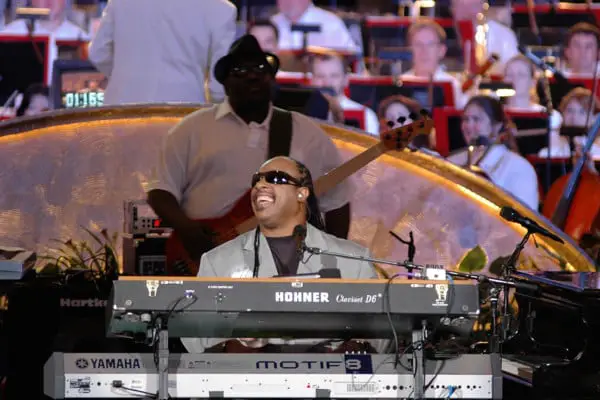Nathan Watts, the musician behind iconic hits from Stevie Wonder, was born on March 25th, 1954, in the vibrant city of Detroit, Michigan. He has laid the groundwork for the most influential music ever recorded. His contributions can be found on albums by esteemed artists such as the Jacksons, Diana Ross, the Pointer Sisters, Gladys Knight and the Pips, Lionel Richie, Herbie Hancock, The Temptations, Sérgio Mendes, and Paul McCartney, among many others.
However, as Stevie Wonder’s long-serving bassist, affectionately referred to as Steve, Nate has gained a reputation as one of the world’s most skilled bass players. Marcus Miller even dubs him ‘the Godfather’.

In August 1974, Nate received a call from Stevie Wonder’s office. Following a recommendation from guitarist Ray Parker Jr., Stevie wanted to hire him for a gig in Memphis, Tennessee. Nate recalls, “I was instructed to learn as many songs as possible. There was no rehearsal; we briefly reviewed a few tunes backstage and then were on stage. The first two songs were ‘Superstition’ and ‘My Cherie Amour,’ I was fine. Then they called ‘Contusion,’ a song I had never heard before, and I froze! I went over and started watching Steve’s left hand and somehow managed to get through it.”
Shortly after, when Stevie’s hit “You Haven’t Done Nothin'” was receiving radio airplay, Nate became his full-time bass player. Nate reflects on the audition process, saying, “I auditioned with two other bassists who were better and more advanced players than me, but I noticed that when Steve played a line and asked us to play it back, I grasped it quicker. Knowing the James Jamerson bassline to ‘I Was Made To Love Her’ during that first concert also impressed him. Ultimately, that helped me secure the gig.”

For any musician growing up in America during the 1950s and 1960s, Detroit was undeniably the place to be. Nate explains, “Living in Detroit, you worked in a factory, went to school, or played music. There was nothing else to do, so I had to play music! I was listening to influential players like James Jamerson, Chuck Rainey, and Joseph ‘Lucky’ Scott, who played with Curtis Mayfield.”
In an interview in April 2006, Nate shared his thoughts on these Stevie Wonder hits and his top five basslines, encompassing a range of instrumental epics and timeless classics.
1. Stevie Wonder - Sir Duke
“We recorded ‘Sir Duke’ at Crystal Industries in Los Angeles. Stevie Wonder rehearsed the entire band, and then we performed it live. I used my 1974 P-Bass with Rotosound strings, recorded directly. Stevie had the unison line, which required me to bend up the last fret to reach the highest note. Stevie allowed me to create the two-feel bassline, and I improvised a bit during the outro.”
2. Do I Do
“That was done at Wonderland. Stevie was comfortable with the whole band by then, so we just went in and jammed, playing whatever we wanted. He gave me more freedom on that song than any other, and Dennis Davis provided a strong and simple foundation on drums. There was a lot of room for me to explore. I used my ’79 MusicMan StingRay, recorded directly without any effects. The gritty, growling sound is simply the natural tone of the bass guitar, combined with the strings tuned down to Eb, which added more buzz and fret noise.”
3. Stevie Wonder - As
“That was a magical session at the Hit Factory in New York City. When I walked in with my P-Bass, I first saw Herbie Hancock! We all sat there – Stevie, Herbie, drummer Greg Brown, and guitarist Dean Parks – and just grooved. This is the first time I’ve experienced something like it. The song held so much meaning, and the lyrics were fantastic, so as we heard them, we kept elevating the performance. I made two rhythmic mistakes – one before the first chorus and one before the last -and asked Stevie if I could fix them, but he liked how they felt.”
4. Contusion
“This one was also rehearsed and recorded at Crystal, using my ’74 P-Bass. I had a little experience playing it live, but Stevie came up with the idea for the intro bassline in the studio. He sang the stuttering 16th note rhythm, and I played it.”
5. I Wish
“That was recorded at 3 am at Crystal, using a Jazz Bass that I had recently purchased. I had been recording all day and had just come home, exhausted, and crawled into bed when Stevie called and said, ‘I need you to come back – I have this amazing song.’ I went back, and he had the eighth-note keyboard bassline, so I joined in, adding my Jamerson-inspired grace notes, which he liked. Then he said, ‘Nate, do this,’ he sang some growly roars, so I started incorporating slides. The engineer, Gary Olazabal, suggested I plug into an Ampeg tube preamp, which he cranked to achieve the growling sound. Apart from that, the slides sound intense because it was 3 in the morning!”
Check out Songs in the Key of Life – The album with all the Stevie Wonder Hits and fantastic bass lines.
Updated – 01/02/2025





